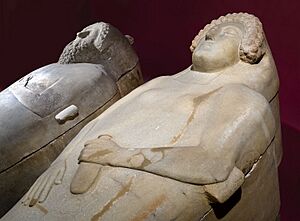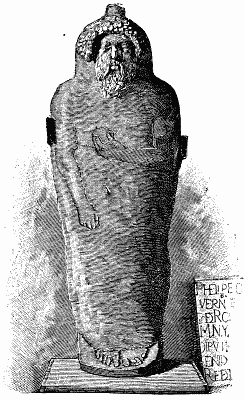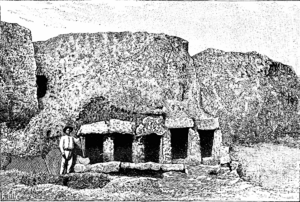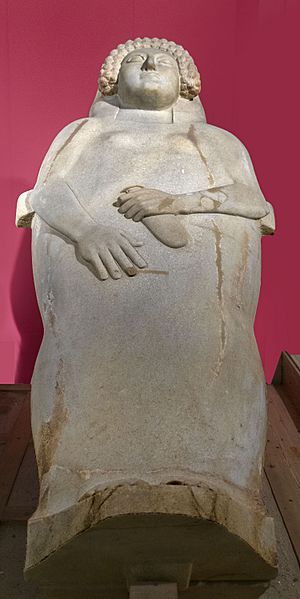Lady of Cádiz facts for kids
Quick facts for kids Lady of Cádiz |
|
|---|---|

The sarcophagus in its current location.
|
|
| Created | 470 BC |
| Discovered | 1980 at Cádiz |
| Present location | Museum of Cádiz |
| Culture | Phoenicia |
The Lady of Cádiz (in Spanish: Dama de Cádiz) is the name archaeologists gave to a special coffin. This coffin, called a sarcophagus, looks like a human body. It was made around 480 BC by the ancient Phoenician people.
It was found in Cádiz, a city in Spain. Back then, Cádiz was known as Gadir and was a very important Phoenician settlement. This is the second Phoenician sarcophagus found in Spain. Both are now on display at the Museum of Cádiz. Recent studies show that the person inside this sarcophagus was actually a strong man, about 45 to 50 years old.
Contents
Discovering Ancient Coffins
The First Find (1887)
In 1887, workers were digging near Cádiz. About five meters (16 feet) underground, they found three simple tombs. These tombs were made of rough limestone. Inside, they found some skeletons, small bronze tools, and a few pieces of jewelry. The jewelry looked like it came from the Middle East.
One of these tombs held a large coffin made from a single block of white marble. This coffin looked like a human body. It was about 2.15 meters (7 feet) long and 0.67 meters (2.2 feet) wide. This special coffin was soon moved to the local museum.
Experts believed this sarcophagus was made by Phoenicians. However, it also showed influences from ancient Greek art. This means it was likely made after 429 BC. The figure on the coffin was a man with a strong nose and thick hair. His beard was braided in an Asian style.
The arms of the figure were bare to the elbow. The feet were simply shown, sticking out from a long robe. The left hand held a fruit, which was a symbol of new life. The right hand once held a painted crown, but its traces are now gone.
This marble coffin was found in a tomb similar to the simpler ones nearby. Experts noted that it looked exactly like other Phoenician coffins found in places like Cyprus and Sicily. This was the first time such a coffin was found in Spain. These first discoveries happened by accident during construction work for the Maritime Arsenal.
More Discoveries (1890–1891)
More discoveries were made starting in 1890, in almost the same spot. Workers found many more tombs, similar to the ones from 1887. These tombs were about three to six meters (10 to 20 feet) underground.
On April 14, 1890, more digging showed that each tomb was about two meters (6.5 feet) deep. Some of the stone boxes had special patterns on their lower parts. Nothing on the outside showed that these hidden coffins were there. This was a common practice, sometimes even with curses carved on them to protect the dead.
The Lady of Cádiz Sarcophagus
How It Was Found
Pelayo Quintero Atauri was an archaeologist who became the director of the Museum of Cádiz. He believed that if a male sarcophagus had been found, there must also be a female one. He spent much of his life searching for it, but he never found it.
The amazing surprise came a century later. The "Lady of Cádiz" sarcophagus was found right under a palm tree. This palm tree was in the old house where Quintero Atauri used to live!
On September 26, 1980, workers were digging foundations for a new building in Cádiz. An excavator hit something hard – it was the marble sarcophagus. The operator found a bone and quickly told the authorities. Ramón Corzo Sánchez, who was the museum director at the time, took charge. He filled the sarcophagus with sand to protect the remains. Then, it was moved to the museum. Another archaeologist, Antonio Álvarez, later restored it for display.
What It Looks Like
The Lady of Cádiz sarcophagus shows a young woman with a calm and beautiful face. It is carved very well from marble. Both the male and female sarcophagi were made in the Phoenician city of Sidon. They were inspired by ancient Egyptian burial styles. Greek artists likely did the actual carving.
These sarcophagi teach us a lot about the daily lives of the Phoenician people. They show how important Cádiz was as a center for the Phoenicians in the western part of Europe. The fact that such large carvings were made thousands of kilometers away from where they were found shows how far the Phoenicians traveled and traded.
This figure still has faint traces of the colors that the artists used to paint the white marble. It is larger than life-size, which was common for these types of burial carvings. The "Phoenician Lady of Cádiz" is one of the oldest carvings of its kind. It was made around 470 BC. This date is very early compared to similar works in other museums around the world. The items found with the sarcophagus were quite simple. This suggests that Phoenician society in Cádiz did not show off their social status with lots of jewelry.
Images for kids
See also
 In Spanish: Dama de Cádiz para niños
In Spanish: Dama de Cádiz para niños
- History of Spain
- List of the Pre-Roman peoples of the Iberian Peninsula
- Tabnit sarcophagus
- Eshmunazar II sarcophagus











